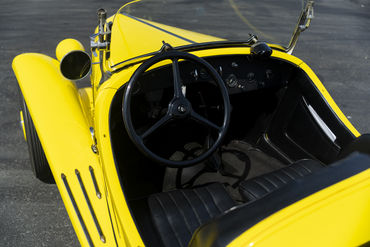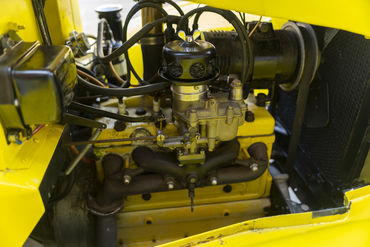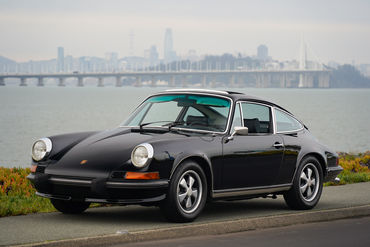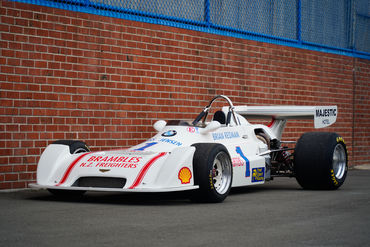Sold
SOLD 09/21
1934 Fiat
508S Balilla Spyder Sport
BaT auction preview: Beautifully proportioned and strong running Fiat 508S. Similar in appearance to an Alfa 8C 2900 at a fraction of the cost.
- VIN508S - 042992
- Exterior ColorYellow
- Interior ColorBlack leather
- Mileage2593 Miles (TMU)
- Engine1000cc Inline-4
- Engine no.108CS-044056
- Transmission4sp Manual
- StatusSold
- StockFJ2512
Description
1934 Fiat 508S Balilla Spider Sport
Chassis No. – 508S-042992
Engine No. – 108 074147 (original engine 108CS-044056)
Exterior Color – Yellow
Interior Color – Black
Engine – 4-cylinder 995cc
Transmission – 4-speed manual
Current Miles – 2,500 (since restoration in early 1970s when the speedo was zeroed out)
Current Owner – Purchased in 2000
Miles driven under current ownership – 100 miles
Highlights for this car
Delightful and rare 508S Spider Sport
Long term ownership spanning 40 years
Detailed history of restoration and mechanical work
General History
Developed as part of the Fiat 508 series cars, the Berlina saloons were the first of the model line and part of an expanding line up of Fiat models for larger volume sales. The 508 Spider was developed as a lightweight two seat, two door variant that would later spawn the more competition-oriented Spider Sport. The low sleek design of the Spider Sport, with its full fenders and distinctive central tail fin, were designed by the famed coachbuilder Ghia. As part of a licensing agreement for manufacturing, many of these cars were assembled in Germany. France, and Czechoslovakia. Built with competition in mind, these cars competed in a range of events including the Mille Miglia and other European races in period. Rare in number and seldom seen in the states, these cars are beautifully designed with visual qualities that echo many of the great Italian cars of the same period, inspiring many automotive journalists to refer to it a “smaller scale version of an Alfa 8C 2900”.
General Overview
Purchased as a project car in 1969 by the former Art Center College of Design Transportation Design Chair, Keith Teter, this rare 508S is one of the very few examples built in the Spider Sport configuration. Teter, working almost entirely on his own, with letters to experts and conversations with colleague and noted automotive scholar Strother MacMinn was able to research the car extensively before starting the restoration in 1971. According to handwritten notation, included with the car, Teter evaluated every part of the car during the process and rebuilt or found suitable substitutes for mechanical details including new babbit bearings for the engine, new valves and guides, new piston rings and pins, and a new timing chain. Egge Engine Machine Co. performed the machine work on the engine including refacing the valve seats, milling the cylinder head, and acid cleaning the block. The engine was bored out to 67mm and pistons were prepared with three compression rings and two oil rings with detailed drawings showing the connecting rod layout and other specifications. Engine measurements, documented June 1972, were carefully retained including a study of the condition of all parts removed from the engine. Even the valves were carefully measured and detailed with accurate drawings showing the measurement references.
The brakes were redone using new American replacement wheel cylinders, the transmission was redone with new bearings and the clutch relined. Here too several components of the gearbox are delineated with reference dimensions for records and future services. The car was painted using acrylic lacquer for the body panels except for the hood side panels which were done in matching acrylic enamel. The underside of the fenders was painted using black polyurethane enamel.
In addition to the detailed notes that accompany the car, Teter, an accomplished car designer and draftsman was careful to annotate and illustrate many parts to identify the hardware, dimensions, and details of the car while under restoration. Several reference photos of the car during the restoration process are included with the notations as well as multiple receipts for parts and materials purchased for the restoration.
Teter retained the car until his passing in the late 1990s. His widow sold the car in 2000 to the current owner, a longtime friend of Teter and member of the Art Center Board. The car has remained with the current owner who has done general service and maintenance on the car including rebuilding the carburetor, adjusting the brakes, refitting the grill, and tending to minor mechanical issues as they come up.
General Condition
Today this Fiat 508S offers driver level cosmetics including glossy paint that has been maintained over the years but is showing typical cracks and chips in the finish commonly found on older lacquer paint work. Given the age of the paint, the finish is still very pleasing, particularly in the vivid yellow hue that suits the unique design. The various chrome trim presents with high gloss and consistent fit to the various body panels. The body panels are very nicely fit and properly contoured including the fenders, doors, hood sections, and trunk lid. The panel gaps are consistent with good closure and tight fit, with excellent drape to the full-length front fenders as they terminate at the rear fender, leaving a hint of a running board. The doors are beautifully dipped down in true roadster style further accented by the raked windscreen.
Unique to the Spider Sport model, the seats are staggered, and the trunk lid terminates with a rising central tail fin which not only gives the car a unique visual signature, it captures the essence of these race-bred models. Outfitted with matching body color wire wheels and period correct tires, the look of the car captures both the grace of the Ghia design and the competition participation that many of these cars enjoyed in period. The car still retains the black and yellow California license plate, which corresponds to the history of this car, dating back to 1969 when first registered by Keith Teter.
The black seats are in excellent condition, while the overall interior presents as a comfortable and usable driver level car with finishes appearing to have been only modestly used since the restoration was completed. The door panels, carpeting, and side panels have a generally good quality feel to the finishes. The dashboard is done in matching black finish, featuring clean and nicely detailed instruments with good color and contrast, consisting of a mix of various newer gauges to monitor critical engine temps and pressure. A modern Fiat gearshift knob completes the interior. The convertible top is stowed in a rolled black wrap that sits behind the staggered seats on an articulating top armature which can be raised and lowered manually.
Under the hood, the engine bay is finished with exterior color including the engine block. The engine block is not matching to the firewall tag and is a flathead design, which is different from the more typically seen overhead valve configuration found in the 1934 SS models. The engine, while mostly period correct, has a few modern improvements from original. The cowl displays the Fiat chassis tag and Frankfurt, Germany construction tag consistent with these cars being built on contract to Fiat. The trunk compartment is clean and well-maintained housing the fuel filler spout, a correctly sized spare tire, and finishes consistent with the rest of the car. The undercarriage is consistent with the restoration showing a clean and dry car that has been stored indoors and used minimally since the restoration was completed.
The car performs very well under general road conditions with delightful driving manners and a decidedly potent exhaust note. One of the earliest sporting examples of small displacement cars, the driving experience is nimble, light, and engaging.
Items Included with the Car
The car is offered with period restoration photos, receipts for parts, drawings, and detailed notations on the restoration by Keith Teter, and additional reference showing the engine during rebuild with notations on engine specifications and build requirements.
Videos
Walkaround: https://youtu.be/2GQOejRCG0o
Driving: https://youtu.be/Dv7hjnugPeM
The above vehicle information is complete and accurate to the best of our knowledge at the time it is posted to this website. Corrections or additional information is always appreciated. All advertised prices exclude government fees and taxes, any finance charges, any dealer document preparation charge, and any emission testing charge. Vehicles are subject to prior sale. All advertised to be true but not guaranteed. We assume no liability for errors or omissions.
Inquire About This Car
Fantasy Junction • 510-653-7555 • 1145 Park Ave, Emeryville, CA 94608





